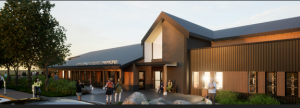The City of Kingston has announced it will be participating as a full Integrated Project Delivery (IPD) partner during construction of the city’s new bridge spanning the Cataraqui River.
The city made the commitment Aug. 22 as it unveiled the team of Peter Kiewit Sons ULC, Hatch Ltd. and SYSTRA International Bridge Technologies as the preferred proponent to undertake detailed design and building of the 1.2-kilometre, $180-million Third Crossing project.
Kingston’s lead project engineer on the build Dan Franco said the city will reap multiple benefits from acting as an IPD partner.
A city statement said this model “allows for an IPD team to build a trusting and valued relationship to verify the preliminary design, to explore innovation and opportunities for efficiency during detailed design, and to have access to a builder’s practicality, promoting an overall efficient construction phase.”
“The IPD model is more common in vertical construction,” Franco said. “But since we are doing it for the first time in North America for a bridge, we are putting ourselves on the radar a bit.
“With IPD, it is working side by side, looking over people’s shoulders and having accountability at all levels. It is an open-book process.”
Franco reported a healthy RFP process, with seven teams responding to the call for proposals.
“We were surprised, we said, ‘this is excellent.’ We had a good cross section,” he said.
The project timeline from here on begins with a validation phase in September, with detailed design targeted for the start of the new year and early-works construction planned to launch next summer. Heavy civil work on the bridge proper is expected to start in 2020.

Franco said the one-third, one-third funding commitments the city received from the federal and provincial governments came with a requirement to complete the project by the end of 2021.
City staff are well positioned to take on the IPD role, he said, with leadership at the top and competence throughout the finance, legal, engineering, purchasing and other departments.
“We are a pretty well-oiled machine,” he said. “We have good communication between the mayor, the CAO and our commissioners so there was a very high degree of confidence in terms of representing the city during the procurement process.
“We are a smart city, that is one of the top priorities of Mayor Bryan Paterson. We want to be at the leading edge of research, procurement and construction practices and material selection and all that.”
Right off the bat, Franco said, during the validation phase, city staff will have an “opportunity to lean on the contractors’ estimators” and work to confirm that the proposed $180-million price tag is reasonable and achievable.
The two main existing structures crossing the Cataraqui River are the 401 bridge to the north and the LaSalle Causeway near the waterfront. The new Third Crossing bridge — to be given an official name at a later date — is about midway between those two, and will link Gore Road and John Counter Boulevard. An environmental assessment confirmed long-held community beliefs that a new crossing was needed to accommodate future growth and reduce congestion on the LaSalle Causeway, among other reasons.
A preliminary design for the bridge prepared by J.L. Richards with other consultants called for what Franco termed an MTO-style box girder bridge with an arch span covering 150 metres.
Franco said the city is eager to participate in the detailed design phase as a way to be involved firming up the project specs, always looking for efficiencies and improvements. As an example, Parks Canada is involved as a caretaker of UNESCO-protected wetlands so there will be discussions on the number of piers — currently set in preliminary designs at 19 piers, 59 metres apart — to determine if more but smaller piers would create less disturbance to the natural environment.
“The language we are using is, how much are we allowed to double back on what’s been done before,” he said. “Nothing is stopping us from reducing the number of piers.
“The key thing about IPD, you share the risk and share the reward, so we have a chance for innovation.”
Among other early participants in the process, Parsons contributed as structural consultants, Golder did geotechnical and other soils-based work, DTAH worked on bridge esthetics and Co Sutherland Wright did preliminary landscape design. Assisting in the lengthy procurement phase that included nine “commercially confidential meetings” with the three final shortlisted teams was Toronto’s The Procurement Office.











Recent Comments